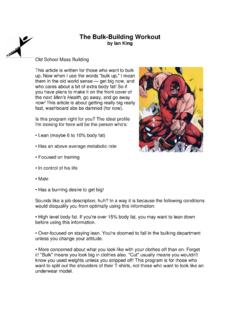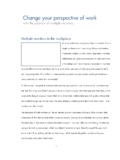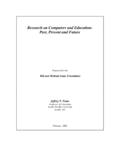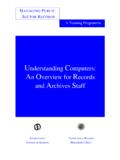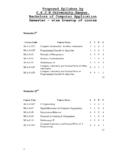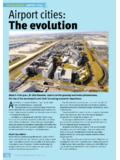Transcription of The Exercise Paradox - Trainingdimensions
1 The Exercise Paradox Studies of how the human engine burns calories help to explain why physical activity does little to control weight and how our species acquired some of its most distinctive traits By Herman Pontzer | Scientific American February 2017 Issue IN B R I E F Conventional wisdom holds that physically active people burn more calories than less active people do. But studies show that traditional hunter-gatherers, who lead physically hard lives, burn the same number of calories as people with access to modern conveniences. The discovery that human energy expenditure is tightly constrained raises questions about how our large brain and other energetically demanding traits evolved.
2 Comparisons with energy expenditure in great apes suggest that the human metabolic engine has evolved to get more work done to support our costly features. Still no giraffe. Four of us had been walking half the day, tracking a wounded giraffe that Mwasad, a Hadza man in his late 30s, shot the evening before. He hit it in the base of the neck from about 25 yards with a steel-tipped, wood arrow smeared with powerful, homemade poison. Hadza are traditional hunter-gatherers who live off of wild plants and animals in the dry savanna wilderness of northern Tanzania. They know the landscape and its residents better than you know your local Trader Joe's.
3 Mwasad had let the giraffe run to give the poison time to work, hoping to find it dead in the morning. An animal that size would feed his family and his camp for a week but only if he could locate it. Mwasad led our party Dave Raichlen from the University of Arizona, a 12-year-old Hadza boy named Neje and me out of camp just after daybreak. Dave and I were of little use in this endeavor. Mwasad had invited us along as a friendly gesture and for the extra help to carry the butchered animal back to camp should our search effort succeed. As anthropologists who study human ecology and evolution, we jumped at the opportunity to tag along Hadza men's tracking abilities are legendary.
4 It certainly beat the prospect of a long day in camp spent fiddling with research equipment. We walked hard for an hour through a pathless, rolling sea of golden, waist-high grass, dotted with brush and thorny acacia trees, directly to the bloody patch where the giraffe was struck. That bit of navigation in itself was quite a trick, like someone leading you to the middle of a 1,000-acre wheat field to show you where he had once dropped a toothpick and then nonchalantly reaching down to pick it up. Hour on hour, tracking the wounded animal under a relentless sun ensued as we followed ever more tenuous signs. Still no giraffe.
5 At least I had water. We sat in the shade of some bushes just after midday, taking a break while Mwasad pondered where the injured creature might head. I had a quart or so left enough, I figured, to get through the heat of the afternoon. Mwasad, however, had not brought any water with him, as is typical of the Hadza. As we packed up to restart the search, I offered him a drink. Mwasad gave me a sideways look, smiled and proceeded to drink the entire bottle in one long pull. When he finished, he casually handed me the empty bottle. It was karma. Dave and I, along with anthropologist Brian Wood from Yale University, had spent the past month living with the Hadza, conducting the first direct measurements of daily energy expenditure in a hunter-gatherer population.
6 We enlisted a couple of dozen Hadza women and men, Mwasad among them, to drink small, incredibly expensive bottles of water enriched in two rare isotopes, deuterium and oxygen 18. Analyzing the concentration of those isotopes in urine samples from each participant would allow us to calculate their body's daily rate of carbon dioxide production and thus their daily energy expenditure. This approach, known as the doubly labeled water method, is the gold standard in public health for measuring the calories burned each day during normal daily life. It is straightforward, completely safe and accurate, but it requires that participants drink every last drop of the enriched water.
7 We had taken pains to make clear that they must not spill, that they had to finish the dose completely. Mwasad seemed to have taken that message to heart. Mwasad's sly joking aside, my colleagues and I have learned a lot about how the human body burns calories through our work with the Hadza. Together with findings from investigators who study other populations, our research has revealed some surprising insights into human metabolism. Our data indicate that, contrary to received wisdom, humans tend to burn the same number of calories regardless of how physically active they are. Yet we have evolved to burn considerably more calories than our primate cousins do.
8 These results help to explain two puzzles that might seem disparate at first but are, in fact, related: first, why Exercise generally fails to aid weight loss and, second, how some of humanity's unique traits arose. T H E C A L O R I E E C O N O M Y Researchers who are interested in human evolution and ecology often focus on energy expenditure because energy is central to everything in biology. One can learn a lot about any species by measuring its metabolism: life is essentially a game of turning energy into kids, and every trait is tuned by natural selection to maximize the evolutionary return on each calorie spent.
9 Ideally, the study population lives in the same environments in which the species originally evolved, where the same ecological pressures that shaped its biology are still at work. That is difficult to achieve with human subjects because most people are divorced from the daily work of acquiring food from a wild landscape. For nearly all the past two million years, humans and our ancestors have been living and evolving as hunter-gatherers. Farming only got going about 10,000 years ago; industrialized cities and modern technology are only a few generations old. Populations such as the Hadza, one of the last hunter-gatherer populations left in the world, are key to understanding how our bodies evolved and functioned before cows, cars and computers.
10 Life for the Hadza is physically demanding. Each morning the women leave the grass huts of camp in small groups, some carrying infants on their back in a wrap, foraging for wild berries or other edibles. Wild tubers are a staple of the Hadza diet, and women can spend hours digging them out of the rocky ground with sticks. Men cover miles each day hunting with bows and arrows they make themselves. When game is scarce, they use simple hatchets to chop into tree limbs, often 40 feet up in the canopy, to harvest wild honey. Even the children contribute, hauling buckets of water back from the nearest watering hole, sometimes a mile or more from camp.

